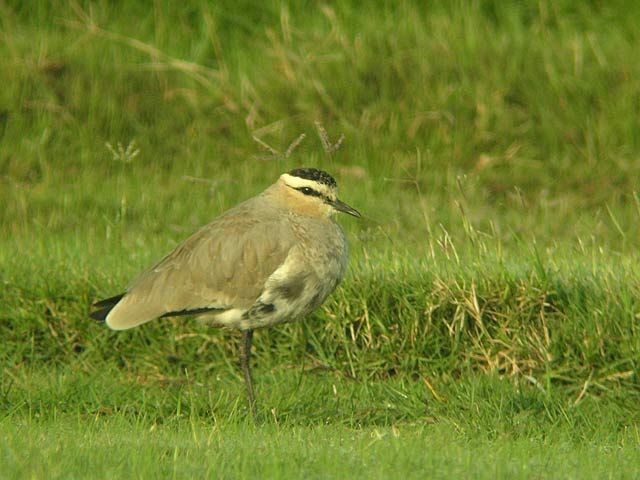 |
| Sociable Lapwing: Dubai, United Arab Emirates. (Photo: Ian Boustead) |
The Sociable Lapwing is a critically endangered species that has undergone a large population decline in recent years. According to recent estimates, the total breeding population is as low as 200-600 breeding pairs. The breeding population of Sociable Lapwing is believed to be concentrated in Kazakhstan with small populations in south-central Russia. The Sociable Lapwing research project was initiated in 2005 in Kazakhstan by a team from the RSPB and the Association for the Biodiversity Protection in Kazakhstan (ACBK) in order to understand the causes of the species decline. In 2006 the team secured funding through the UK Government's Darwin Initiative programme that will allow work to continue until 2009.
Work on the breeding grounds
The core study area is in the Korgalzhyn region of central Kazakhstan. At the main project site data have been collected on breeding distribution, nest survival, causes of nest loss, and chick survival. Breeding colonies appear to be concentrated around human settlements where short vegetation is present due to the presence of livestock grazing. A total of 252 nests have been located, and monitored, to date. In 2005 and 2006 respectively, 46 nests out of 85 (54%), and 93 nests out of 167 nests (55%), successfully hatched at least one chick. During three years of fieldwork, around 600 Sociable Lapwings, mainly chicks, were colour-ringed. Chicks were located, whenever possible, in the nest scrape and uniquely colour-ringed with a combination of four colour rings above the tibio-tarsal joint. Following colour-ringed chicks was found to be a more effective method of quantifying chick survival than radio tracking. Chick survival was high, with approximately one chick fledging per breeding female. This level of chick productivity exceeds that required by closely related species, such as Northern Lapwing, to maintain population stability.
Recent discoveries
In September 2006 a team of researchers from Russia, Kazakhstan and the UK undertook surveys of a known staging area in south-western Russia. The team located flocks of up to 200 birds at Chagraiskoje reservoir in the Stavropol region, including two colour-ringed first year birds ringed on the breeding grounds in central Kazakhstan.
Last month, a team consisting of Dutch ornithologists, local conservationists and guides started survey work in order to find wintering Sociable Lapwings in Syria. Last week, the project team reported the discovery of large flocks of Sociable Lapwings in the north-eastern part of the country. The project team, splitting into two groups, counted over 1,200 birds in one day, one of the highest counts of this species in the last few decades.
The birds were discovered near a hunting party, but conservationists from the survey team, with the support of BirdLife Middle East and the RSPB, collaborated with the hunters to ensure this flock of rare birds were not disturbed.
Both the expeditions in south-west Russia and Syria were partially sponsored by the UK Government's Darwin Initiative, in the framework of the "Sociable Lapwing Project."
This week more exciting news followed. A group of Turkish ornithologists from the local BirdLife partner Doga Dernegi, in response to the discoveries of Sociable Lapwing flocks in Syria, conducted a survey of the territories adjacent to the Syrian border in southern Turkey. On the third day they had their biggest count of 1,017 Sociable Lapwings. At the moment the Turkish and Syrian teams are planning to carry out simultaneous counts to clarify whether the flocks on both sides of the border are different.
The findings in Syria and Turkey have given a burst of energy and optimism to conservationists from different countries, working on saving this rare bird from extinction in Kazakhstan, Russia and Middle East.
Plans for the future
The fieldwork will continue in 2007 in the core study area in central Kazakhstan to confirm the results of the previous years, as well as to widen the area of search within the potential species distribution area. In addition, this year more work will be done searching possible breeding grounds in Russia, and further surveys will be carried out at the known stopover sites and possible wintering grounds in the Middle East.
For further information contact:
Maxim Koshkin, ACBK (Association for the Biodiversity Protection in Kazakhstan), Sociable Lapwing project co-ordinator. Email: maxim.koshkin@acbk.kz.
Dr Rob Sheldon, RSPB, Project Leader - conserving a flagship steppe species: the critically endangered Sociable Lapwing. Email: Robert.Sheldon@rspb.org.uk.
The project "conserving a flagship steppe species: the critically endangered Sociable Lapwing" is part funded by the UK Government's Darwin Initiative.


